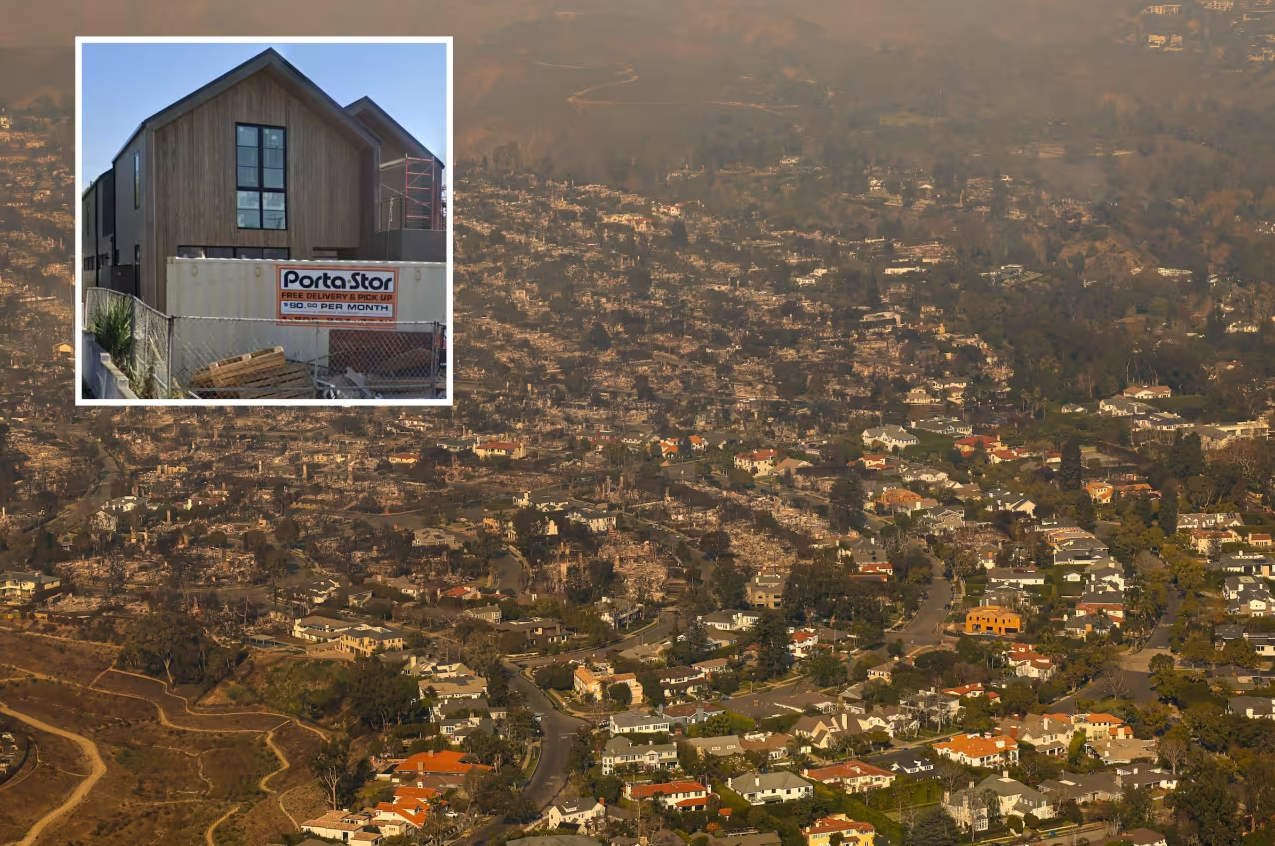View Pricing | Explore the property and pick your lot! See all available lots and pricing

News
Passive Design May Have Saved This House From Destruction in Pacific Palisades
Jan 11, 2025 | Home Design |

Experts provide some answers as to how a home on Iliff Street remained fully intact amid a scorched neighborhood
Amid the absolute devastation in Los Angeles neighborhood Pacific Palisades, where fires have reduced blocks of homes to charred rubble, there is a single house on Iliff Street that remains intact.
Its neighbor to the left is gone, except for a single exposed wall and a burned-out pickup truck in the driveway whose wheels melted in the heat of the blaze, leaving a trail of molten rubber.
“No words really—just a horror show,” wrote architect Greg Chasen on X with a picture of the untouched house. “Some of the design choices we made here helped. But we were also very lucky.”
Those design choices include a simple facade, with no eaves or overhangs where embers can catch on, reinforced windows, and a concrete perimeter wall that was singed by the burning pickup truck next door, according to Chasen’s online comments.
These design are all consistent with the principles of passive house standards, a construction method focused on minimizing the energy footprint of a structure and which has also proven to be more fire resistant than typical construction methods.
That’s because the key element of passive house construction is its protective envelope, which is coupled with an efficient air ventilation system known as HRV (heat recovery ventilation), to reduce the home’s exposure to the elements—thus minimizing its energy footprint, said Ken Levenson, the executive director of the New York-based Passive House Network.
The sealed environment ends up providing protection from other outdoor elements, including noise, pollution, smoke and in extreme cases, fire. “The insulation, coupled with airtightness, really protects the structure from boiling,” Levenson said.
The owner of the Iliff home, an executive at MGM, completed the new 3,624-square-foot home just six months ago but has owned the lot since 1998, according to property records. The family moved in last year and evacuated earlier this week, he said in an interview with NBCLA. Chasen and the owner could not immediately be reached for comment.
While the home survived, the vast majority of its neighbors were not so lucky. Multiple blazes are continuing to rage in the Los Angeles area, as firefighters struggle to contain the most destructive fires the city has ever seen. Since Tuesday, the Palisades and Eaton fires have destroyed over 33,000 acres and more than 10,000 buildings, while additional fires are burning in Ventura County and the San Fernando Valley, amid unusually high winds and dry conditions for this time of year. The death toll had risen to 10 by Friday afternoon.
While it was not immediately clear whether the home met passive house standards, the design was certainly consistent with its principles, said Johnny Rezvani, communications director for passive house supply company 475 High Performance Building Supply.
“Regardless of whether this particular structure is certified or the designer had passive-house principles in mind, it is congruent with several aspects of passive house that increase chances of surviving a fire such as this one,” Rezvani said.
Both Rezvani and Levenson were involved in encouraging the adoption of passive house methods in the aftermath of the Marshall Fire in Colorado in 2022, which destroyed almost 1,000 structures and spread under very similar conditions to the Los Angeles infernos.
There are several critical design elements in passive-house construction that helped protect against fire.
“First off, passive houses tend to have a simplified compacted form for homes, because it’s more efficient, and that reduces places for embers to lodge in the structure,” said Rezvani, which is the case with the Iliff Street house.
Second, the airtightness of the envelope, which includes reinforced windows, and just two vents for the air-filtration system, means there are fewer points of entry for embers—the primary way that fires like this one spread. “If you have a leaky envelope for the home, if you have leaky windows and doors, they can literally be pulling embers in,”explained Rezvani.
To assist with the airtightness of the home, most passive houses will wrap the home in insulation, but will eschew the standard foam insulation—which is flammable—for more sustainable materials like mineral wool or wood fiber board manufactured with borates, which are less flammable, said Eliason.
“That basically wraps your house in a fire resistant blanket, or puffy coat,” he said.
While it may be counterintuitive to wrap a building in wood fiber to make it more fire resistant, it’s a tested method, said Levenson.
“The wood fiber is actually dense enough so that it chars and prevents the building from burning, like heavy timber,” he said.
For fire-prone regions, another benefit of passive house construction is that even if the house is not in danger, it protects residents from toxic smoke events. “With the combination of airtight construction, triple vane windows and the HRV—the lungs of the building—you get a building that’s smoke tight,” Eliason said.
Chasen, the architect of the Iliff Street house, wrote on X that there was no smoke damage in the home, which he’d already visited since the fire next door. Similarly, Mark Attard, an architect whose Louisville, Colorado, home survived the Colorado Marshall Fire shortly after he retrofitted it to passive house standards, also found that his home was undamaged by smoke, unlike nearby homes.
Of course, there were other factors that contributed to the survival of the Iliff Street house, including the landscaping and materials used, neither of which are core to passive house principles. The Iliff house had a gravel yard with very little brush, and the lot to the left had been cleared several weeks earlier so it was more protected on that side.
“If you look at the yard, it’s a gravel yard with a bunch of plants that are small and not brown and grassy and not right up against the house,” Rezvani said.
Unfortunately, that is the exception to the rule. “In Southern California, people put these very grassy bushes all around the front of buildings,” said Rezvani, “That’s literally tinder.”
A spokesperson for the National Fire Protection Association declined to comment on the home in question, but said there were two general ways to protect a home from wildfires.
“One is to clear debris, vegetation, and other combustible items from near and around the home,” the spokesperson wrote in an email. “The other way to help reduce homes’ risk to wildfires is to build homes with structural features that minimize the likelihood of conflagration.”
Ultimately, though, it’s important to note that wildfires behave differently under different conditions, and that there are no guarantees, Eliason said.
“Passive house methods certainly enhance [the] ability to withstand a wildfire, but there’s no perfect protection.”
)